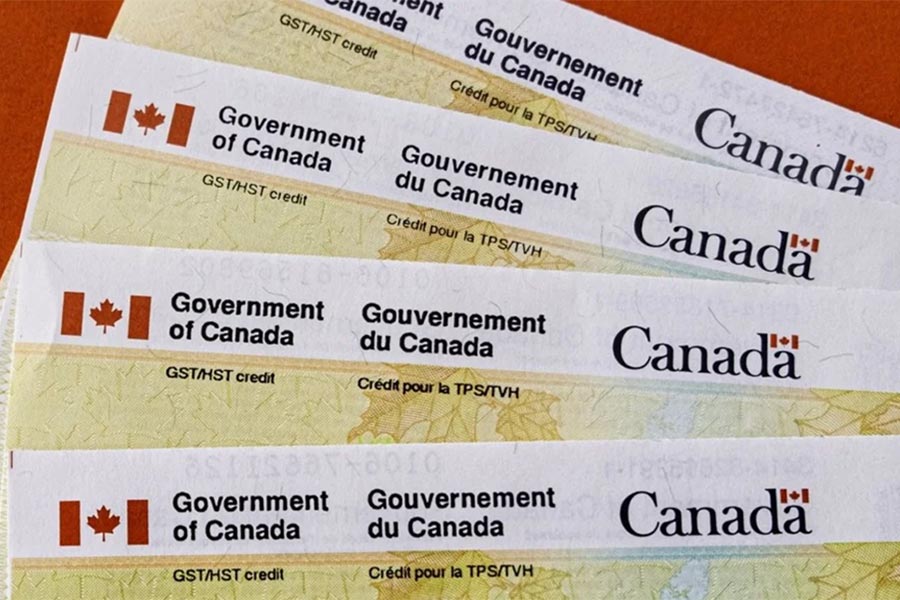Last Updated on April 9, 2025


Hey there, fellow Canadians! Ever wonder what the Goods and Services Tax (GST) and Harmonized Sales Tax (HST) Credit is all about? You’re not alone. The GST/HST credit is a financial lifeline for many of us, especially those with low to modest incomes. This tax-free quarterly payment is designed to help offset the GST or HST you pay on goods and services. Let’s unravel the mystery of the GST/HST credit together, so you can make the most of this valuable benefit. We’ll explore what it is, who qualifies, how to apply, and more!
What is GST/HST Credit?
So, what exactly is the GST/HST credit? At its core, the Goods and Services Tax (GST) and Harmonized Sales Tax (HST) Credit is a tax-free quarterly payment. It’s like getting a little financial boost every three months to help cover the GST or HST you pay on everyday purchases. This credit is especially helpful for individuals and families with lower incomes, making it a bit easier to manage those monthly expenses.
The GST was introduced in Canada back in 1991, and the HST followed in 1997 in some provinces, combining the federal GST with provincial sales tax. The idea behind the GST/HST credit is to provide financial relief to those who need it most, ensuring that the tax burden doesn’t disproportionately affect low-income Canadians.
Eligibility for GST/HST Credit
Now, let’s talk eligibility. To get your hands on the GST/HST credit, you need to meet a few criteria. First and foremost, you must be a resident of Canada for income tax purposes. This means that you need to have a significant presence in the country and be subject to Canadian income tax.
But wait, there’s more! You also need to meet certain criteria regarding age, marital status, and income level. Here’s a quick rundown:
- Age: You must be at least 19 years old or older.
- Marital Status: Whether you’re single, married, or in a common-law relationship, your marital status will impact your eligibility and the amount of credit you receive.
- Income Level: Your family net income plays a crucial role. Generally, individuals and families with lower incomes are eligible for higher credits.
The Canada Revenue Agency (CRA) uses your income tax return to determine your eligibility and calculate your credit amount. So, make sure you file your taxes on time to ensure you’re in the running for the credit.
How to Apply for GST/HST Credit
Applying for the GST/HST credit is a breeze. All you need to do is file your income tax return. Yep, it’s that simple! The CRA will take care of the rest, automatically determining your eligibility and calculating your credit amount based on the information you provide.
Here’s a step-by-step guide to help you through the process:
- File Your Income Tax Return: Make sure you file your income tax return every year, even if you don’t have any income to report. This is crucial for the CRA to assess your eligibility.
- Provide Accurate Information: Double-check your personal information, including your marital status and the number of children you have, to ensure accuracy.
- Wait for Notification: The CRA will notify you if you’re eligible for the GST/HST credit and let you know the amount you’ll receive.
And voilà! You’re all set to receive your quarterly payments.
GST/HST Credit Payment Dates
Timing is everything, especially when it comes to those much-anticipated credit payments. The GST/HST credit is paid out quarterly, typically in January, April, July, and October. Mark your calendars because these dates can vary slightly each year.
| Quarter | Payment Month | Payment Date (Approximate) |
|---|---|---|
| Q1 | January | Around January 5th |
| Q2 | April | Around April 5th |
| Q3 | July | Around July 5th |
| Q4 | October | Around October 5th |
Here’s what you can expect:
- January: Kick off the new year with a little financial boost.
- April: Just in time for spring, another payment to help with those extra expenses.
- July: Summer’s here, and so is your quarterly credit.
- October: Get ready for the fall with another round of payments.
Keep an eye on your mailbox or bank account because the CRA will send you either a direct deposit or a cheque. If you’re ever unsure about the exact payment dates, the CRA website has a handy schedule to keep you in the loop.
Curious more about GST/HST payment dates and schedules? Read this detailed article for all the information you need!
Calculating GST/HST Credit Amount
Now, let’s break down how the CRA calculates your GST/HST credit amount. It’s not a one-size-fits-all situation; the amount you receive depends on several factors:
- Family Net Income: The CRA uses your family net income from your income tax return to determine your credit amount. The lower your income, the higher the credit you may receive.
- Number of Children: If you have children under the age of 19, you’ll receive additional credits for each child.
- Marital Status: Whether you’re single, married, or in a common-law relationship, your marital status impacts your credit amount.
To make things easier, the CRA provides an online GST/HST credit calculator. This handy tool allows you to enter your income and family details to get an estimate of your credit amount. It’s a great way to get a ballpark figure of what you can expect.
How Much GST/HST Credit Can You Receive?
The amount of GST/HST credit you can expect to receive in 2025 depends on your adjusted family net income, marital status, and the number of children under 19 years of age in your care. For the 2023 base year (which determines payments from July 2024 to June 2025), the maximum amounts are as follows:
- $519 if you are single.
- $680 if you are married or have a common-law partner.
- $179 for each child under the age of 19.
These payments are issued quarterly and are tax-free. The Canada Revenue Agency (CRA) calculates your eligibility and payment amounts based on your previous year’s tax return. Changes in your family net income, marital status, or the number of eligible children can affect the amount you receive.
If you’d like a more personalized estimate, you can use the CRA’s Child and family benefits calculator.
What is the Maximum Income to Qualify for GST/HST?
The maximum income to qualify for the GST/HST credit depends on your family size and marital status. Below is a detailed breakdown of the maximum yearly entitlement for the 2025 payment period (based on the 2023 base year): For the updated figures check this GST/HST Credit page.
Single Individuals
- No children: Maximum credit of $519 if your income is below $54,704.
- 1 child: Maximum credit of $859 if your income is below $61,504.
- 2 children: Maximum credit of $1,038 if your income is below $65,084.
- 3 children: Maximum credit of $1,217 if your income is below $68,664.
- 4 children: Maximum credit of $1,396 if your income is below $72,224.
Married or Common-Law Couples
- No children: Maximum credit of $680 if your family income is below $57,924.
- 1 child: Maximum credit of $859 if your family income is below $61,504.
- 2 children: Maximum credit of $1,038 if your family income is below $65,804.
- 3 children: Maximum credit of $1,217 if your family income is below $68,664.
- 4 children: Maximum credit of $1,396 if your family income is below $72,244.
Income Thresholds
As your adjusted family net income increases, the GST/HST credit amount gradually decreases. For example:
- Single individuals earning $54,704 or more will receive $0.
- Married couples with four children earning $72,244 or more will receive $0.
These amounts are paid quarterly and are tax-free. The Canada Revenue Agency (CRA) uses your previous year’s tax return to determine eligibility and payment amounts. Changes in marital status, family size, or income can affect your entitlement.
Impact of Income Changes on GST/HST Credit
Life is full of changes, and your GST/HST credit can be affected by changes in your income, marital status, or number of children. It’s important to keep the CRA informed of any changes to ensure you receive the correct amount.
Here’s how different changes can impact your credit:
- Income Changes: If your family net income increases or decreases, it will directly affect the amount of GST/HST credit you receive. A higher income may reduce your credit, while a lower income may increase it.
- Marital Status Changes: Getting married, entering a common-law relationship, or separating can impact your credit amount. Make sure to update your marital status with the CRA.
- Number of Children: If you have a new child or your child turns 19, it will affect the additional credits you receive for each child.
To report changes, you can use the CRA’s “My Account” online service or contact them directly. Keeping your information up-to-date ensures you receive the correct amount and avoid any surprises.
GST/HST Credit for Newcomers to Canada
Welcome to Canada! If you’re new to the Great White North, you might be eligible for the GST/HST credit. Newcomers to Canada can qualify for this financial benefit if they meet certain residency and income requirements.
Here’s what you need to know:
- Residency Requirements: You must be a resident of Canada for income tax purposes. This means you have established significant ties to the country, such as having a home, a spouse or common-law partner, and dependents in Canada.
- Income Requirements: Your family net income must fall within the eligible range to qualify for the credit.
- File an Income Tax Return: Even if you arrived in Canada partway through the year, make sure to file an income tax return to apply for the GST/HST credit.
Once you’ve filed your taxes, the CRA will assess your eligibility and calculate your credit amount. It’s a great way to get a little financial support as you settle into your new life in Canada.

More GST/HST Credit FAQs
You probably have a few questions about the GST/HST credit, and that’s perfectly normal. Here are some common questions and answers to help clear things up:
For more detailed information and answers to other questions, the CRA website is a fantastic resource.
Conclusion
The GST/HST credit is a valuable benefit designed to ease the financial burden of taxes for eligible Canadians. By understanding the application process, eligibility criteria, and how to report changes in your situation, you can ensure you receive the maximum benefit available. Whether you’re a long-time resident or a newcomer to Canada, the GST/HST credit can provide a little extra financial support to help you manage your expenses.
So, fellow Canadians, take advantage of this benefit and make the most of your GST/HST credit. Stay informed, keep your information up-to-date, and enjoy the peace of mind that comes with a little extra financial assistance. If you have any more questions or need further details, the CRA website is always there to help. Here’s to making the most of every loonie and toonie!
Statistics and Information Sources:
- Government of Canada website
- Link: https://www.canada.ca/en/revenue-agency/services/child-family-benefits/goods-services-tax-harmonized-sales-tax-gst-hst-credit.html






